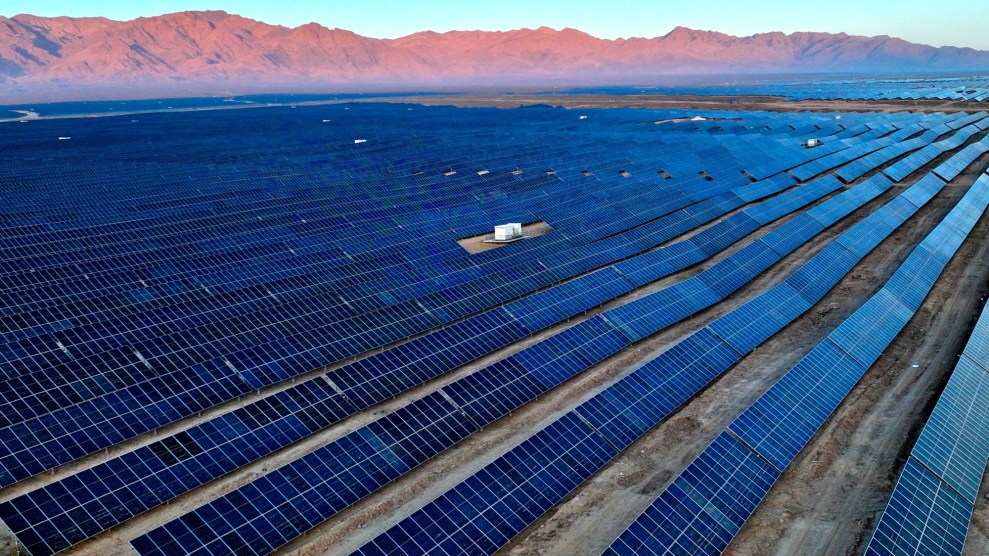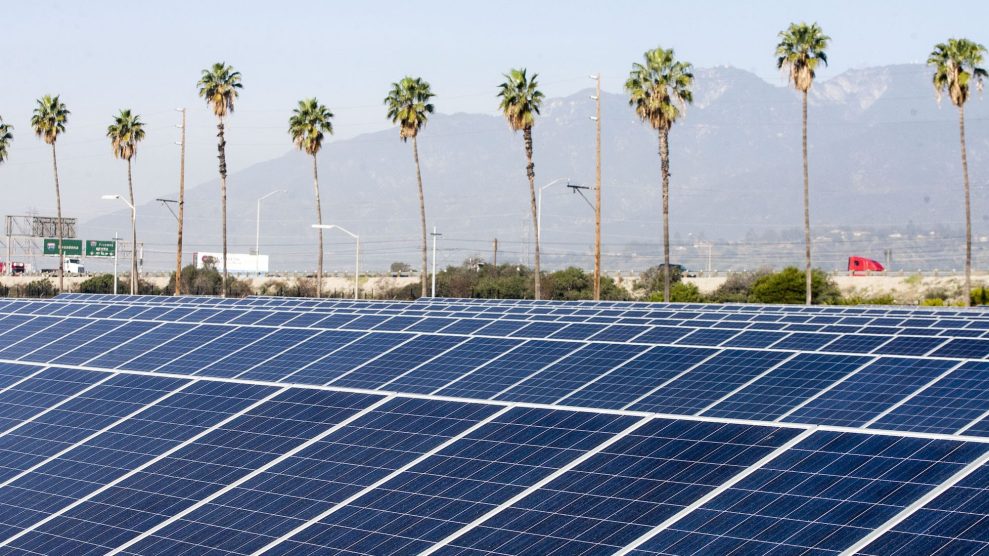
A photovoltaic array at a new energy base in Zhangye city, China.Cfoto/ZUMA
This story was originally published by Inside Climate News and is reproduced here as part of the Climate Desk collaboration.
The global transition to clean energy has a cost, but it may be a lot lower than the figures that sometimes get thrown around. The differences are large, amounting to trillions and even tens of trillions of dollars.
A new analysis from RMI, the clean energy research and advocacy group, identifies what its authors say is a basic flaw in many of those estimates: They don’t fully take into account the decrease in fossil fuel spending.
“This kind of narrative that there’s a massive surge in capital that’s required is simply incorrect,” said Kingsmill Bond, a co-author of the report and an analyst for RMI whose work covers the financial side of the energy transition.
The report finds that global capital spending (money used for equipment and property, among other things) on energy supply is on track to be about $2.5 trillion in 2030, up from $2.2 trillion in 2023.
“It’s 2 percent per annum growth,” Bond said. “On a net basis, it’s not much.”
The RMI analysis doesn’t take into account any of the financial benefits of limiting the harm of climate change, such as reduction in heat-related medical issues and property damage.
The report serves as a counterpoint to estimates from organizations including McKinsey & Company and the International Energy Agency.
McKinsey, the management consulting firm, said in a 2022 report that spending on energy and land-use systems in the net-zero transition would cost an average of $9.2 trillion per year between 2021 and 2050, which is an annual increase of about $3.5 trillion per year from what was then the current spending level. McKinsey’s authors noted that this increase would be the equivalent of half of global corporate profits and one-quarter of global tax revenue.
That sounds scary—and it’s misleading, according to Bond. McKinsey is making an unfair comparison, he said, because the global economy and energy spending are both growing, and would grow regardless of whether the system was based on fossil fuels or not.
A fairer comparison would be between an economy aiming for net-zero emissions and one with a “business as usual” scenario with a slower transition to clean energy, he said. McKinsey includes this kind of comparison later in its report, showing that the average annual increase for a net-zero scenario is about $1 trillion per year. (McKinsey did not respond to a request for comment.)
IEA says that capital spending on energy was $2.8 trillion in 2023 and will rise to more than $4 trillion in 2030 under the “net zero emissions” scenario, which is one of the several scenarios in its World Energy Outlook. (Paris-based IEA does research to help its 31 member countries, including the United States, plan and manage to meet their energy needs.)
Bond and his co-authors argue that IEA is misleading in its estimates because it is lumping together several categories of capital costs, some of which are more appropriate to include than others.
I asked IEA for a response.
“It’s a bit difficult to respond as many of the points are unclear or couched quite vaguely,” said Tim Gould, IEA’s chief energy economist, in an email.
He said IEA clearly accounts for declines in fossil fuel capital spending, so he thinks this aspect of RMI’s critique is misplaced.
The clash is largely about how those declines are calculated and communicated. I can see what RMI is saying and can also understand why IEA is confident in its approach.
It’s important to specify that RMI’s report uses IEA spending estimates as the basis of its analysis, so the two have a lot in common. The difference is that RMI is making what the authors say are justified adjustments to IEA’s numbers as part of a larger argument that a decline in fossil fuel spending should be viewed as reducing the cost of the energy transition.
I find Bond’s way of framing this topic to be compelling, including the idea that the world has more than enough money to pay for a rapid transition.
But there are some shortcomings in speaking so broadly about a shift whose pace will vary a lot by country and region. The report acknowledges that there is a lack of available data to estimate costs in emerging markets, like regions within Africa. If the transition in those places is unusually slow and expensive, it could undercut the main thrust of the report’s argument.
Bond said he and others at RMI are working to get a better handle on costs in the places where this information is often lacking.
One of my main takeaways from this report is that the transition to clean energy is not some strange thing with astronomical costs that should be feared. It’s the track we’re already on. The key question is not the destination, but how quickly we will get there. Fossil fuel companies have a lot to gain from a slow transition, and that’s what animates much of the discussion we’re having and will continue to have.
















